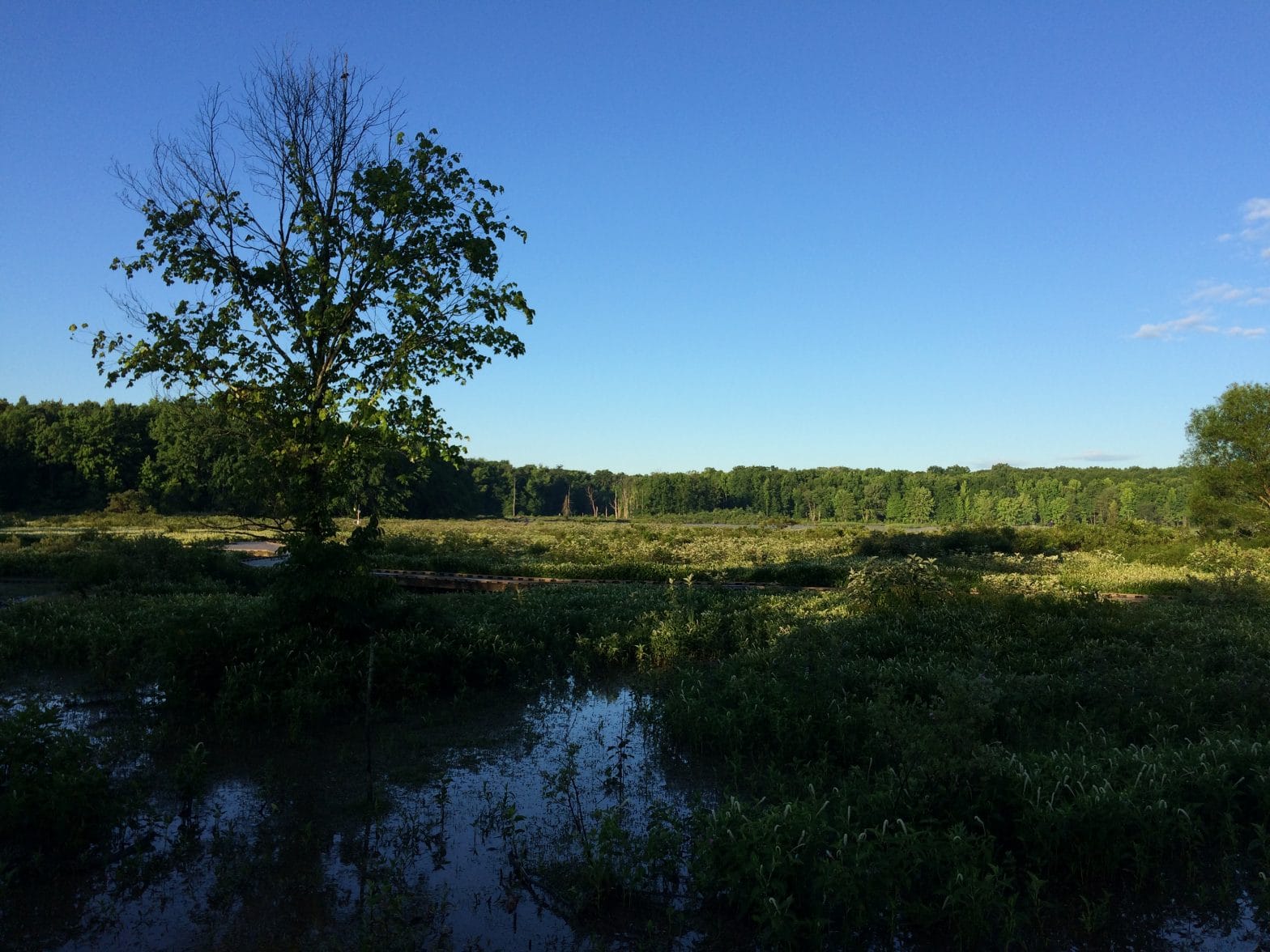Booker, Haaland Release Climate Bill Focused on Farm Programs, Reforestation, and Wetlands Restoration

Freshman U.S. Representative Deb Haaland, D-N.M., joined U.S. Senator Cory Booker, D-N.J., in introducing a climate change bill focused on voluntary farm and ranch conservation practices, massive reforestation, and wetlands restoration.
The lawmakers say the Climate Stewardship Act of 2019 was inspired by measures implemented in President Franklin D. Roosevelt’s New Deal.
If implemented in its entirety, it would support voluntary climate stewardship practices on more than 100 million acres of farmland, plant more than 15 billion trees to revive deforested landscapes and expand urban tree cover, and reestablish the Civilian Conservation Corps — one of the New Deal’s most popular programs, they said.
It also aims to restore over two million acres of coastal wetlands, and invest in renewable energy for farmers and rural small businesses in the spirit of the New Deal’s Rural Electrification Act, which provided low-cost loans to help bring electricity to rural America.
Haaland, chairwoman of the House Natural Resources Subcommittee on National Parks, Forests, and Public Lands, said in a statement that “climate change is an immediate threat our communities face that calls for bold solutions. However, deforestation and some current agricultural practices are making global warming worse.
“I’m excited to work with Senator Cory Booker on the Climate Stewardship Act, to incentivize farming practices that reduce emissions and promote reforestation. These steps are important to reversing climate change impacts that threaten the health and safety of our communities and our planet,” she said.
In the wake of last year’s dire United Nations report detailing the urgency and scale at which we must act to address the climate change crisis and reach net zero emissions, this legislation provides nature-based solutions to remove heat-trapping carbon dioxide from the atmosphere.
Federal greenhouse gas inventories show that currently our soils, forests, and wetlands sequester approximately 11 percent of all U.S. emissions, but the potential exists to substantially increase such sequestration by implementing the types of natural climate solutions included in this proposal — planting more trees, restoring wetlands, and greatly scaling up the adoption of farm and ranch conservation practices.
A recent report identified tree planting and ecosystem restoration as one of the most effective potential solutions to mitigating climate change.
The trees planted by this bill will sequester over 13 billion metric tons of carbon dioxide – equivalent to more than two years of current total U.S. greenhouse gas emissions.
“In FDR’s New Deal, the federal government planted billions of trees, provided conservation incentives to family farmers and ranchers, created hundreds of thousands of jobs in the Civilian Conservation Corps, and electrified rural America,” Senator Booker said.
“In order to address the urgent and existential threat posed by climate change, all of these approaches should be part of our broader strategy,” he continued. “In addition to transitioning from fossil fuels to clean energy, another essential step that we must take is to increase the carbon sequestration in our soils, forests, and wetlands.”
“This legislation will not only reduce emissions and substantially increase carbon sequestration, but will also create hundreds of thousands of new jobs, enhance biodiversity by restoring tens of millions of acres of habitat, and make our farms more resilient and competitive,” Booker said.
The 2018 National Climate Assessment details how farmers and ranchers are already being harmed by climate change, and outlines how rising temperatures and extreme weather could lead to substantial reductions in future crop yields in many regions of the country.
“After another year of extreme weather, no one understands the impacts of climate change better than our family farmers and ranchers,” Booker said. “While our farmers face unique impacts from climate change, our farmers are also uniquely positioned to capture and store carbon in the ground, produce clean energy, and to reduce emissions. The same farmland practices that store carbon and reduce emissions also improve the ability of our farms to withstand extreme weather, reduce water pollution and protect drinking water, and reduce flood damages by storing and slowly releasing flood waters.”
“Farmers need only look out our back doors to see how climate change is having a dramatic effect on our way of life,” said Wes Shoemyer, Family Farm Action Board Member and Missouri farmer. “The farmers I know are great patriots and so they stand ready to be part of the solution. FDR knew in the 1930s that family farmers were the backbone of our rural economy and the best stewards of our natural resources.”
“The Climate Stewardship Act is the most ambitious legislation in our nation’s history to mobilize America’s forests as a climate change solution,” said Jad Daley, President and CEO of American Forests, the nation’s oldest forest conservation organization founded in 1875. “Best of all, the Climate Stewardship Act brings everyone on board to help, in cities and rural communities alike, and creates paid employment for people who need these opportunities most. As the organization that spurred creation of the original Civilian Conservation Corps in 1933, American Forests especially appreciates this focus on creating green jobs from the important work of solving climate change with forests.”
According to the release, the Climate Stewardship Act will:
- Plant over 4 billion trees by 2030, and 15 billion trees by 2050, on a combination of federal, state, local, tribal, and non-governmental lands. The ambitious level of tree planting outlined in the Climate Stewardship Act makes it the biggest reforestation measure ever to be introduced in Congress.
- Plant over 100 million of these trees in urban neighborhoods across America, with the priority going to low-income neighborhoods and communities of color. In addition to sequestering carbon, trees also absorb harmful air pollutants and reduce temperatures in urban areas.
- Support voluntary climate stewardship practices on over 100 million acres of farmland, reducing or offsetting agricultural emissions by one-third by 2025, through:
- Providing tens of billions of dollars of supplemental funding for USDA working lands conservation programs, with new funding dedicated to stewardship practices such as rotational grazing, improved fertilizer efficiency, and planting tens of millions of new acres of cover crops.
- Protecting millions of acres of environmentally sensitive farmland.
- Doubling funding for agricultural research programs, including more funding for soil health demonstration trials.
- Tripling USDA funding to provide farmers with expert technical assistance on climate stewardship practices.
- Providing grant funding to tens of thousands of farmers, ranchers and rural businesses for renewable energy production, such as solar panels and wind turbines, and energy efficiency improvements.
- Invest in local and regional food systems to increase resilience in rural and urban communities.
- Restore or protect over 2 million acres of coastal wetlands by 2030 to sequester carbon emissions and reduce coastal flooding. Coastal wetlands act as an important sponge during extreme weather events with heavy rainfall. For example, although New Jersey has lost more than 40 percent of its coastal wetlands, the wetlands remaining helped prevent $625 million of property damage during Hurricane Sandy in 2012.
- Reestablish the Civilian Conservation Corps to provide youth from low-income communities, indigenous communities, and communities of color with skills and work experience in forestry and wetlands restoration.
The Climate Stewardship Act of 2019 is endorsed by more than 60 farmer, environmental, restoration, and forestry organizations. A full list of endorsing organizations can be found here.
More information on the Climate Stewardship Act of 2019 is available in the section-by-section summary here and the full text here.























